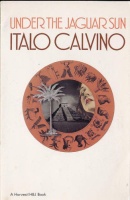
"A scent always dissipates, leaving in its wake no more than a faint echo, a lingering trace. Perfume is a 'here' en route to a 'there', a today floating away in the direction of a yesterday, a possession paradoxically coinciding with an immanent loss" (Richard Stamelman, p.19).
The notion of perfume as the 'essence of absence' has always been a great source of inspiration to poets and novelists. Few, however, have taken it as literally as Italo Calvino in his tale The Name, the Nose. This short story was published posthumously in 1986, together with A King Listens and Under the Jaguar Sun, and consists of three interwoven plots in which sensuality, desire, and the sense of smell play a central role. We follow three males (one of them is actually an early primate, who barely walks erect) on their quest to find a woman/female they've met once before; their only lead is a particular perfume, a haunting body odor, or a distinct smell they can't get out of their mind. (Spoilers ahead!)
The first story line unfolds in a prestigious perfumery on the Champs-Elysées, where a 19th century Parisian nobleman tries to identify the perfume of a woman he met at a masked ball. With the help of the knowledgeable Madame Odile he finds the unique scent the lady was wearing, and manages to obtain her address. Blinded by desire, he rushes to her premises; but as he arrives at the villa, a funeral is in process. The woman he longed for lays peacefully in a coffin: her face is covered by a black veil, her distinct perfume mixed with the smell of death. An elderly man with a red fez tells him that she had already died when they allegedly met.
A similar fate awaits the female in the second story line, this time witnessed from the perspective of a primate. Smells surround him everywhere; like the creatures that emanate them, they can be friendly or hostile, filled with love or hate. The tale of the naive savage, who successfully traces back his woman by her smell (and finds her dead in a ditch) is all the more touching for it. A far cry from the Parisian high society, but altogether not so remote from the third story, which is set at a party of a London-based rock band. After a wild night of sex, drugs and alcohol, the lead singer smells the soft pale skin of a girl lying naked on the floor, amidst a pile of groupies; the room is still dark. A few hours later, as all the party people are gone and the first rays of light start entering the room, he discovers her lifeless body still lying there on the floor.
What Calvino does so brilliantly in these (otherwise simple) little stories, is to uncover the very complex relation between smell, desire and loss. He embarks on similar analytical explorations in A King Listens (hearing) and the title story Under the Jaguar Sun (taste), but The Name, the Nose is my favorite by far. His sharp observations on perfume culture, thoughtfully condensed on the first page, will tickle the thoughts of any fragrance lover. More in general, Calvino's novels always make sense in a funny or twisted way, whether he tells the tale of a man who is literally cut in two (The Cloven Viscount) or that of a boy who decides to excuse himself from the rest of the world (The Baron in the Trees). A world where fantasy meets reality often makes difficult concepts easier to grasp.
While he didn't live long enough to finish his project on the five senses, the three stories in Under the Jaguar Sun are little gems, waiting to be discovered by a larger audience. I'm not familiar with the English translation, so I hope it does justice to the excellent original prose. Perhaps a little note of caution: The Name, the Nose was first published in the Italian edition of Playboy magazine (1972), and may indeed not be suitable for weakhearted souls.
New and second hand copies can be easily obtained for as little as $11 USD; most paperback editions are about 75 pages long. Original title: Sotto il sole giaguaro. Milan: Garzanti (1986)
 Italo Calvino (1923-1985) was an Italian writer. He was the author of The Cloven Viscount (1959), The Baron in the Trees (1957), The Nonexistent Knight (1959), Marcovaldo (1963), Invisible Cities (1972), If On a Winter's Night a Traveler (1979) and many other novels and essays.
Italo Calvino (1923-1985) was an Italian writer. He was the author of The Cloven Viscount (1959), The Baron in the Trees (1957), The Nonexistent Knight (1959), Marcovaldo (1963), Invisible Cities (1972), If On a Winter's Night a Traveler (1979) and many other novels and essays.
Note: image of Italo Calvino via Italo Calvino: la vita e le opere.
Leave a reply
You must be logged in to post a comment.